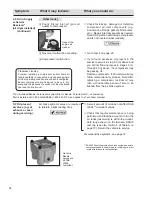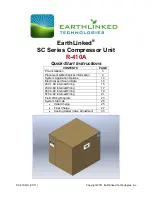
3
LUBRICATION
The vehicle's engine provides a continuous supply of oil
to the compressor. Oil is routed from the engine to the
compressor oil inlet. An oil passage in the crankshaft
conducts pressurized oil to precision sleeve main bearings
and to the connecting rod bearings. Spray lubrication of
the cylinder bores, connecting rod wrist pin bushings, and
ball type main bearings is obtained as oil is forced out
around the crankshaft journals by engine oil pressure.
Oil then falls to the bottom of the compressor crankcase
and is returned to the engine through drain holes in the
compressor mounting flange.
COOLING
Air flowing through the engine compartment from the
action of the engine fan and the movement of the vehicle
assists in cooling the compressor. Cooling fins are part
of the crankcase/cylinder block casting. Coolant flowing
from the engine cooling system through connecting lines
enters the head and passes through internal passages in
the cylinder head and valve plate assembly and is returned
to the engine. Proper cooling is important in minimizing
discharge air temperatures. Figure 8 illustrates the coolant
flow connections. See the tabulated technical data in the
back of this manual for specific requirements.
PREVENTATIVE MAINTENANCE
Regularly scheduled maintenance is the single most
important factor in maintaining the air brake charging
system.
Refer to Table A in the Troubleshooting section
for a guide to various considerations that must be given to
maintenance of the compressor and other related charging
system components.
Important Note:
Review the warranty policy before
performing any intrusive maintenance procedures. An
extended warranty may be voided if intrusive maintenance
is performed during this period.
EVERY 6 MONTHS, 1800 OPERATING HOURS
OR AFTER EACH 50,000 MILES WHICHEVER
OCCURS FIRST PERFORM THE FOLLOWING
INSPECTIONS AND TESTS.
AIR INDUCTION
BA-922
®
compressors are only permitted to be naturally
aspirated - use of the engine turbocharger as an air source
is not allowed.
FIGURE 6 -
OPERATION - LOADED (COMPRESSION)
Piston Moving Up
Air Inlet
Port
Inlet
Valve
Closed
Air
Discharge
Port
Discharge
Valve
Unloader
Piston
Down &
Seated
Valve
Plate
Unloader
Port
FIGURE 7 -
OPERATION - UNLOADED
Unloader
Piston
Up &
Unseated
Air From
Governor
Unloader
Port
Air Inlet Port
Valve
Plate
Air in Pistons Mostly Shuttles Back
and Forth from One Piston to the
Other During Unloaded Mode
Unloader Piston
Up & Unseated




































